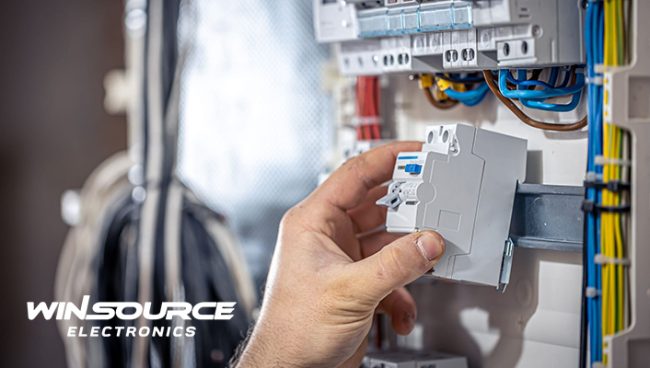
Circuit breakers are becoming increasingly crucial as electrical systems and the demand for electricity both rise. People encounter circuit breakers every day, and although many of us need to give these devices more thought, they are necessary to support everything from our most routine tasks to our most ambitious endeavors.
What are Circuit Breakers?
A circuit breaker is a safety device that guards against overload or short circuit situations that could harm electrical appliances or circuits. Its features have made it beneficial equipment for switching and safeguarding different power system components. A circuit breaker is essential for protecting the appliances, the circuit, and our house from accidents caused by overload or short circuit conditions. One specific example of this product is the Sensata Airpax Circuit Breaker (IEGS6-1-63 10.0.01).
How Does a Circuit Breaker Work?
Since a circuit breaker safeguards electrical installations, it cuts off the electric current when it reaches its design limits, preventing harm to the circuit and providing energy to the loads. In other words, the device will trip and stop any further current flow if the electric current delivered to your blow dryer from the power supply exceeds a preset amount for your circuit breaker.
The Sensata Airpax Circuit Breaker (IEGS6-1-63 10.0.01), for instance, is a magnetic circuit protector that provides low-cost power switching, reliable circuit protection, and accurate circuit control, making it safe and convenient to use.
Different Types of Circuit Breakers
Circuit breakers have three basic types: Standard Circuit Breakers, GFCI Circuit Breakers, and AFCI Circuit Breakers.
Standard Circuit Breakers
Most homes and small businesses that use 120V or 240V single-phase electric power use standard circuit breakers. Standard Circuit Breakers have two types: Single-Pole Circuit Breakers and Double-Pole Circuit Breakers.
The most prevalent kind of circuit breakers in homes nowadays are single-pole models because they are made to monitor the current flowing through a single wire and trip in the case of an electrical overload or short. Single-pole breakers are designed to supply 120 volts to the circuit and handle 15 to 30 amps.
On the other hand, Double-pole circuit breakers concurrently monitor two wires’ worth of electrical current. They can be quickly identified as a single breaker with two side-by-side, connected switches. If one or both cables short out or get overloaded, this kind of breaker will trip.
GFCI Circuit Breakers
Ground Fault Circuit Interrupter (GFCI) Circuit Breakers cut off a circuit if there is a risk of electrocution and the electrical current is flowing in an unauthorized direction. This is referred to as a line-to-ground problem in technical jargon.
A ground fault occurs when a conductor—anything that carries electricity, such as metal pipes, equipment components made of metal, or even water—comes into contact with the current’s electrical route.
AFCI Circuit Breakers
Arc Fault Circuit Interrupters (AFCI) cut off power when they detect an electrical arc. When a current flowing through a wire diverges, an electrical arc happens.
This might occur if a malfunctioning or damaged electrical cable causes the current to “jump” to another place. Such arcs can ignite items nearby and release a great deal of heat.
Hydraulic Magnetic Circuit Breaker
Unlike traditional thermal-magnetic circuit breakers, which rely on a bimetallic strip to provide thermal protection, hydraulic-magnetic circuit breakers utilize a hydraulic delay mechanism and a magnetic trip element for accurate and consistent circuit interruption.
One popular example of this type of circuit protector is Sensata Airpax Circuit Breaker with product number IEGS6-1-63 10.0.10 V. This product is designed to provide protection against electrical shock in a diverse range of applications and high-risk environments.
Benefits of Using Circuit Breakers and Protectors
It can be inconvenient to deal with power issues brought on by a high electric current flow rate; after all, it could lead to a possible fire and equipment failure. This is precisely where circuit breakers, such as the IEGS6-1-63 10.0.10 V, come in. But that’s not the only benefit that circuit breakers can bring. Here are the benefits of using circuit breakers and protectors:
They provide enough electrical current
Major appliances demand much more electrical current than lighting and smaller equipment. If you plug an electric range or dishwasher into a regular electrical outlet, your home’s electrical system will be immediately overwhelmed with power.
Using a dedicated circuit, you can ensure your device gets enough electrical power without worrying about overcharging the other outlets in your house.
They remove electrical safety concerns
Creating specialized circuits throughout your home might help maintain the security and safety of your electrical system. If an item is linked to a regular circuit instead of a specialized one, it could increase the risk of an electrical fire in your house.
After you fit your new dedicated circuits, it will surely make you feel more comfortable with your new appliances.
They offer convenience and ease of use
Unlike fuses, which need to be changed regularly, electric breakers, such as the IEGS6-1-63 10.0.010 V, are readily reset after tripping. Because customers don’t have to wait for a professional to repair their fuses or keep extra fuses on hand, this convenience saves time and money.
As silent defenders, circuit breakers and protectors watch over the flow of electrons and are prepared to cut the connection at the first sign of trouble. As such, it’s always a good sign that you have one installed and know the right place where you can get them. As the top distributor of electronic components, WIN SOURCE provides convenient, ready-to-ship electronic parts you need in your everyday life. With our wide range of electronic parts and components, you’ll find everything you’ll ever need.
© 2024 Win Source Electronics. All rights reserved. This content is protected by copyright and may not be reproduced, distributed, transmitted, cached or otherwise used, except with the prior written permission of Win Source Electronics.

COMMENTS